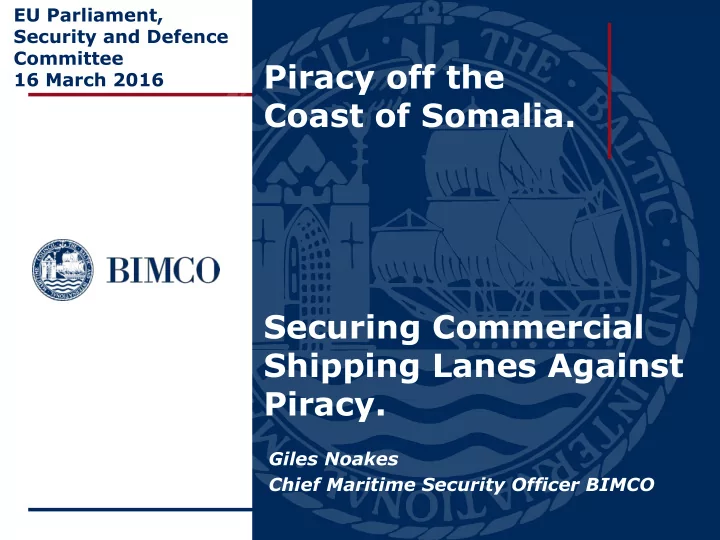

EU Parliament, Security and Defence Committee Piracy off the 16 March 2016 Coast of Somalia. Securing Commercial Shipping Lanes Against Piracy. Giles Noakes Chief Maritime Security Officer BIMCO
Aim/Industry Concerns To maintain the security of commercial shipping lanes we have to avoid ending up going off in the wrong direction at the wrong time Will address: 1. What industry is currently doing. 2. Why piracy is being deterred but could start again. 3. Why any proposal to increase/rely upon the use of PCASP as a solution is unsound.
Industry Counter Piracy Role • Review and maintain best possible guidance on counter piracy to Ship Owners and Masters in order to: • Avoid • Deter • Delay • Guidance and Processes defined in BMP4. • Guidance nuanced by threat awareness (e.g. SHADE) and response awareness (e.g. MSCHOA/UKMTO)
New HRA Effective 1 Dec 2015
The Threat of Somali Piracy………… Today • Piracy is suppressed - not eliminated • The threat has not completely gone away • Risk of resurgence of Somali Pirates exists • Illegal fishing off Somalia has reemerged as a problem • The intent , capability and opportunity for Somali pirates to attack merchant ships remains.
The Importance of Maintaining the Deterrence “Milking Stool • Pirate activity has been deterred successfully because of three major counter piracy initiatives/legs: • Naval Forces • BMP • PCASP • If one leg goes then the stool will fall over and deterrence will fail
The Importance of Maintaining the Naval Presence • Deterrence is a mix of credibility and visibility – key factors: • Visible • Prospect of military response • High risk of arrest and prosecution (only states/military have are legally empowered) • Military have limited pirate operations and their ability to put to sea • The ending of the mandate would send a wrong and dangerous message to pirates given the threat.
PCASP. How Have We Arrived Here ? • Traditionally war and/or counter insurgency post conflict has required privatisation. • But .......Now - A blurring of boundaries • Asymmetric warfare • Law enforcement • Often exacerbated by • Lack of or no legal infrastructures • Ofen a law enforcement vaccum, not war fighting. • Insufficient initial deterrence called for under UNCLOS lead to Business ” buying” security as the only alternative when BMP insufficient. • GUARDCON contract to protect both parties • But – a danger of becoming institutionalized for the wrong reasons
Risk Analysis drives PCASP use • Use of PCASP is a last resort in a layered counter piracy defence and the level of risk due to vulnerability demands placed on ships. • Not deployed on all ships. Many rely entirely on BMP4 • Always driven by risk analysis and ….. • The “ low and slow “ factor • Example today can be found in over 80% of ships transiting the Somalis basin are still using armed guards but only 20% east of 65 East.
Limitations on PCASP viability as a solution. 1. The reduction in real deterrence 2. The inability to arrest and prosecute 3. The shortfall of quality PCASP needed suddenly in volumes 4. The necessary proliferation of floating armouries – contrary to littoral state desires 5. Legal issues and ramifications: • RUF • Variations in international law 6. A real risk of escalation of violence 7. Inability to use “citadels” 8. Historical precedent is unrealistic
Main Messages – The Need for a Sustained Effort - Efficient but Effective. • Mandates: A visible and credible international presence needs to remain in theatre to ensure that piracy does not return. • Industry must maintain vigilance and remain committed to counter-piracy measures including registering with MSCHOA, reporting to UKMTO and implementing ship protection measures on the basis of a thorough risk assessment. • There will be other changes to the HRA and to the international naval presence – but - this should not be an excuse for complacency .
THANK YOU FOR YOUR TIME ANY QUESTIONS
Recommend
More recommend